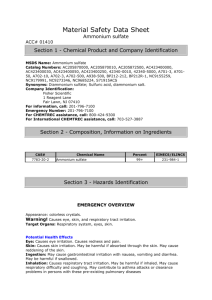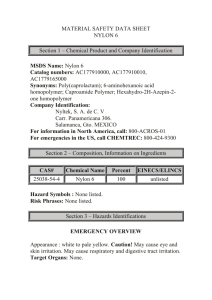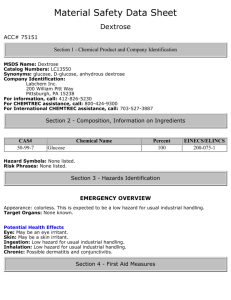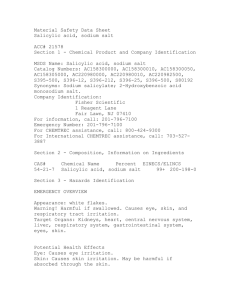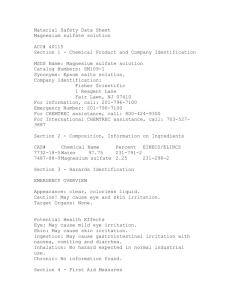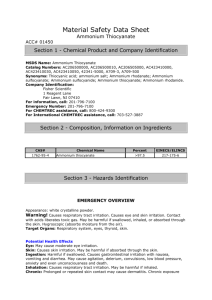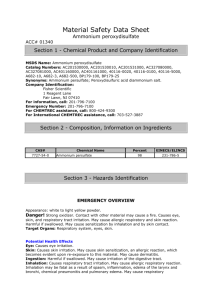Ammonium Sulfide MSDS - UCSB Nanofabrication Facility Signup Site
advertisement
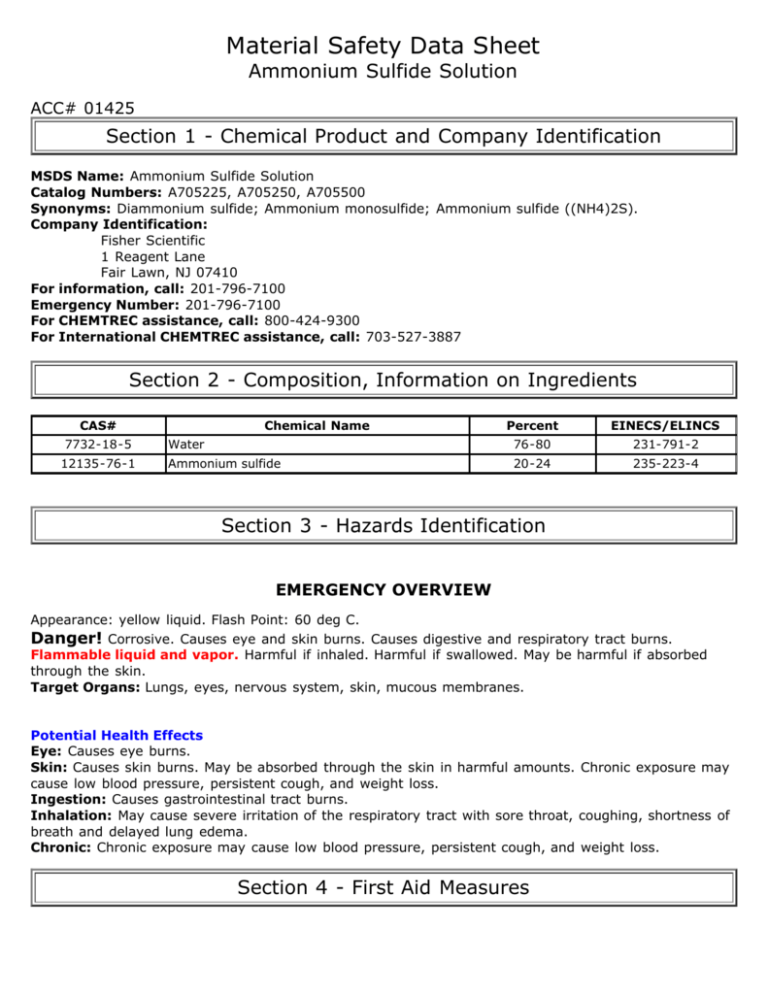
Material Safety Data Sheet Ammonium Sulfide Solution ACC# 01425 Section 1 - Chemical Product and Company Identification MSDS Name: Ammonium Sulfide Solution Catalog Numbers: A705225, A705250, A705500 Synonyms: Diammonium sulfide; Ammonium monosulfide; Ammonium sulfide ((NH4)2S). Company Identification: Fisher Scientific 1 Reagent Lane Fair Lawn, NJ 07410 For information, call: 201-796-7100 Emergency Number: 201-796-7100 For CHEMTREC assistance, call: 800-424-9300 For International CHEMTREC assistance, call: 703-527-3887 Section 2 - Composition, Information on Ingredients CAS# 7732-18-5 12135-76-1 Chemical Name Percent EINECS/ELINCS Water 76-80 231-791-2 Ammonium sulfide 20-24 235-223-4 Section 3 - Hazards Identification EMERGENCY OVERVIEW Appearance: yellow liquid. Flash Point: 60 deg C. Danger! Corrosive. Causes eye and skin burns. Causes digestive and respiratory tract burns. Flammable liquid and vapor. Harmful if inhaled. Harmful if swallowed. May be harmful if absorbed through the skin. Target Organs: Lungs, eyes, nervous system, skin, mucous membranes. Potential Health Effects Eye: Causes eye burns. Skin: Causes skin burns. May be absorbed through the skin in harmful amounts. Chronic exposure may cause low blood pressure, persistent cough, and weight loss. Ingestion: Causes gastrointestinal tract burns. Inhalation: May cause severe irritation of the respiratory tract with sore throat, coughing, shortness of breath and delayed lung edema. Chronic: Chronic exposure may cause low blood pressure, persistent cough, and weight loss. Section 4 - First Aid Measures Eyes: Immediately flush eyes with plenty of water for at least 15 minutes, occasionally lifting the upper and lower eyelids. Get medical aid imme diately. Skin: Get medical aid immediately. Immediately flush skin with plenty of water for at least 15 minutes while removing contaminated clothing and shoes. Ingestion: Do not induce vomiting. If victim is conscious and alert, give 2-4 cupfuls of milk or water. Never give anything by mouth to an unconscious person. Get medical aid immediately. Inhalation: Remove from exposure and move to fresh air immediately. If not breathing, give artificial respiration. If breathing is difficult, give oxygen. Get medical aid. Notes to Physician: Treat symptomatically and supportively. Section 5 - Fire Fighting Measures General Information: Vapors may form an explosive mixture with air. Use water spray to keep fireexposed containers cool. Wear appropriate protective clothing to prevent contact with skin and eyes. Wear a self-contained breathing apparatus (SCBA) to prevent contact with thermal decomposition products. Containers may explode in the heat of a fire. Flammable liquid and vapor. Extinguishing Media: For small fires, use dry chemical, carbon dioxide, water spray or alcohol-resistant foam. Flash Point: 60 deg C ( 140.00 deg F) Autoignition Temperature: Not applicable. Explosion Limits, Lower:Not available. Upper: Not available. NFPA Rating: (estimated) Health: 3; Flammability: 2; Instability: 0 Section 6 - Accidental Release Measures General Information: Use proper personal protective equipment as indicated in Section 8. Spills/Leaks: Absorb spill with inert material (e.g. vermiculite, sand or earth), then place in suitable container. Remove all sources of ignition. Provide ventilation. Approach spill from upwind. Section 7 - Handling and Storage Handling: Wash thoroughly after handling. Use with adequate ventilation. Loosen closure cautiously before opening. Do not get in eyes, on skin, or on clothing. Empty containers retain product residue, (liquid and/or vapor), and can be dangerous. Keep container tightly closed. Do not ingest or inhale. Do not pressurize, cut, weld, braze, solder, drill, grind, or expose empty containers to heat, sparks or open flames. Storage: Keep away from heat, sparks, and flame. Store in a tightly closed container. Store in a cool, dry, well-ventilated area away from incompatible substances. Flammables-area. Section 8 - Exposure Controls, Personal Protection Engineering Controls: Facilities storing or utilizing this material should be equipped with an eyewash facility and a safety shower. Use adequate general or local exhaust ventilation to keep airborne concentrations below the permissible exposure limits. Exposure Limits Chemical Name Water ACGIH none listed NIOSH OSHA - Final PELs none listed none listed Ammonium sulfide none listed none listed none listed OSHA Vacated PELs: Water: No OSHA Vacated PELs are listed for this chemical. Ammonium sulfide: No OSHA Vacated PELs are listed for this chemical. Personal Protective Equipment Eyes: Wear chemical splash goggles. Skin: Wear appropriate gloves to prevent skin exposure. Clothing: Wear appropriate protective clothing to prevent skin exposure. Respirators: Follow the OSHA respirator regulations found in 29 CFR 1910.134 or European Standard EN 149. Use a NIOSH/MSHA or European Standard EN 149 approved respirator if exposure limits are exceeded or if irritation or other symptoms are experienced. Section 9 - Physical and Chemical Properties Physical State: Liquid Appearance: yellow Odor: sulfurous odor pH: Not available. Vapor Pressure: Not available. Vapor Density: >1 Evaporation Rate:Not available. Viscosity: Not available. Boiling Point: Not available. Freezing/Melting Point:Not available. Decomposition Temperature:Not available. Solubility: Soluble in water. Specific Gravity/Density:Not available. Molecular Formula:(NH4)2S Molecular Weight:68.15 Section 10 - Stability and Reactivity Chemical Stability: Stable under normal temperatures and pressures. Conditions to Avoid: Incompatible materials, ignition sources, excess heat. Incompatibilities with Other Materials: Contact with strong oxidizers may cause fire. Incompatible with alkalies, strong acids, copper, brass, bronze, strong bases, zinc, and aluminum. Contact with incompatible materials may release poisonous and flammable hydrogen sulfide gas. Hazardous Decomposition Products: Nitrogen oxides, oxides of sulfur, ammonia and/or derivatives, hydrogen sulfide. Hazardous Polymerization: Has not been reported. Section 11 - Toxicological Information RTECS#: CAS# 7732-18-5: ZC0110000 CAS# 12135-76-1 unlisted. LD50/LC50: CAS# 7732-18-5: Oral, rat: LD50 = >90 mL/kg; . CAS# 12135-76-1: . Carcinogenicity: CAS# 7732-18-5: Not listed by ACGIH, IARC, NTP, or CA Prop 65. CAS# 12135-76-1: Not listed by ACGIH, IARC, NTP, or CA Prop 65. Epidemiology: No data available. Teratogenicity: No data available. Reproductive Effects: No data available. Mutagenicity: No data available. Neurotoxicity: No data available. Other Studies: Section 12 - Ecological Information No information available. Section 13 - Disposal Considerations Chemical waste generators must determine whether a discarded chemical is classified as a hazardous waste. US EPA guidelines for the classification determination are listed in 40 CFR Parts 261.3. Additionally, waste generators must consult state and local hazardous waste regulations to ensure complete and accurate classification. RCRA P-Series: None listed. RCRA U-Series: None listed. Section 14 - Transport Information US DOT Canada TDG Shipping Name: AMMONIUM SULFIDE SOLUTION AMMONIUM SULFIDE SOLUTION Hazard Class: 8 8(3)(6.1)(9.2) UN Number: UN2683 UN2683 Packing Group: II II Section 15 - Regulatory Information US FEDERAL TSCA CAS# 7732-18-5 is listed on the TSCA inventory. CAS# 12135-76-1 is listed on the TSCA inventory. Health & Safety Reporting List None of the chemicals are on the Health & Safety Reporting List. Chemical Test Rules None of the chemicals in this product are under a Chemical Test Rule. Section 12b None of the chemicals are listed under TSCA Section 12b. TSCA Significant New Use Rule None of the chemicals in this material have a SNUR under TSCA. CERCLA Hazardous Substances and corresponding RQs CAS# 12135-76-1: 100 lb final RQ; 45.4 kg final RQ SARA Section 302 Extremely Hazardous Substances None of the chemicals in this product have a TPQ. SARA Codes CAS # 12135-76-1: immediate, fire, reactive. Section 313 No chemicals are reportable under Section 313. Clean Air Act: This material does not contain any hazardous air pollutants. This material does not contain any Class 1 Ozone depletors. This material does not contain any Class 2 Ozone depletors. Clean Water Act: CAS# 12135-76-1 is listed as a Hazardous Substance under the CWA. None of the chemicals in this product are listed as Priority Pollutants under the CWA. None of the chemicals in this product are listed as Toxic Pollutants under the CWA. OSHA: None of the chemicals in this product are considered highly hazardous by OSHA. STATE CAS# 7732-18-5 is not present on state lists from CA, PA, MN, MA, FL, or NJ. CAS# 12135-76-1 can be found on the following state right to know lists: California, New Jersey, Pennsylvania, Massachusetts. California Prop 65 California No Significant Risk Level: None of the chemicals in this product are listed. European/International Regulations European Labeling in Accordance with EC Directives Hazard Symbols: T C Risk Phrases: R 10 Flammable. R 21 Harmful in contact with skin. R 23/25 Toxic by inhalation and if swallowed. R 34 Causes burns. Safety Phrases: WGK (Water Danger/Protection) CAS# 7732-18-5: No information available. CAS# 12135-76-1: 2 Canada - DSL/NDSL CAS# 7732-18-5 is listed on Canada's DSL List. CAS# 12135-76-1 is listed on Canada's DSL List. Canada - WHMIS This product has a WHMIS classification of B3, D1B, E. This product has been classified in accordance with the hazard criteria of the Controlled Products Regulations and the MSDS contains all of the information required by those regulations. Canadian Ingredient Disclosure List CAS# 12135-76-1 is not listed on the Canadian Ingredient Disclosure List. Section 16 - Additional Information MSDS Creation Date: 9/02/1997 Revision #7 Date: 2/11/2008 The information above is believed to be accurate and represents the best information currently available to us. However, we make no warranty of merchantability or any other warranty, express or implied, with respect to such information, and we assume no liability resulting from its use. Users should make their own investigations to determine the suitability of the information for their particular purposes. In no event shall Fisher be liable for any claims, losses, or damages of any third party or for lost profits or any special, indirect, incidental, consequential or exemplary damages, howsoever arising, even if Fisher has been advised of the possibility of such damages.



